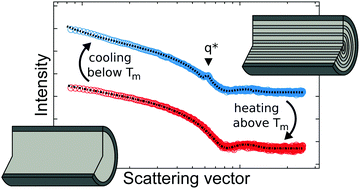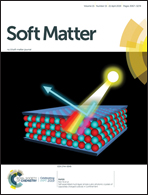Oriented crystallization of PEG induced by confinement in cylindrical nanopores: structural and thermal properties†
Abstract
Nanoporous ion track-etched polycarbonate is ideally suited for the study of confined polymers via small angle X-ray scattering (SAXS) due to the strictly parallel orientation of the pores as well as their uncorrelated lateral distribution. Nanopores with radii ranging from 17 to 213 nm are prepared and coated with SiO2via atomic layer deposition in order to obtain a well-defined and homogeneous surface. A low molecular weight polyethylene glycol (PEG) homopolymer with a semicrystalline lamellar bulk structure is introduced into the nanopores via melt infiltration. At high temperatures SAXS measurements confirm a uniform filling of the pores with amorphous polymer. Upon cooling below the melting point of PEG, a concentrical structure of semicrystalline lamellae is revealed for large pore radii. We introduce models which successfully describe the combined scattering from nanopores and semicrystalline or amorphous PEG inside. DSC measurements of the confined polymer show a decrease of melting temperature and heat of fusion per gram polymer upon reduction of the pore radius and hint at a change in the lamellar configuration.



 Please wait while we load your content...
Please wait while we load your content...